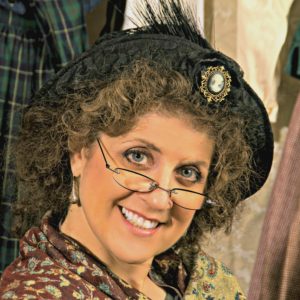 I’ve decked the halls at the Ross Ranch with all manner of Christmas splendors, adorning trees and every random corner of the house for the holidays.
I’ve decked the halls at the Ross Ranch with all manner of Christmas splendors, adorning trees and every random corner of the house for the holidays.
I have three Christmas trees, each dressed in a different theme: The Victorian, The Woodland, and The Vintage Childhood. I love them all but am especially partial to The Vintage Childhood because it reflects my personal memories of Christmas past in my 1960s youth. Vintage ornaments from the era drape the branches, while displayed underneath are some of the actual toys I received on long ago Christmas mornings. I enjoy them more today, decades later, than at the first.
One of the treasures I found each year under the tree during my elementary school days was a new Nancy Drew Mystery Story. My collection of titles still holds a place of honor on our library shelves. I knew I could count on Santa to have a Nancy Drew mystery waiting for me on Christmas morn. The cover and frontispiece prepared me for what to expect once I started reading. I was never disappointed.
Only inspired.
I credit Nancy Drew as my earliest writing mentor. Reading her mystery adventures became more than just the absorbing of a captivating story. It stirred the latent author within me. I wanted to be able to write a book just like Carolyn Keene.
But, if Nancy Drew’s life was full of mysteries, Carolyn Keene was a mystery in and of herself. I could learn nothing about her when I was young. Other authors might be featured in magazines with photographs and details of their personal lives. But not Carolyn Keene.
When I dug a little deeper on the subject through the years, I learned that Carolyn Keene was a pen name for an anonymous writer shrouded in mystery. In fact, she had been hidden from public view since the first Nancy Drew book was written in 1929. By the time I started reading them in the mid to late 1960s, dozens of her detective adventures had been published.
But not until a court case in 1980 regarding the publishers of the series, did Nancy Drew fans learn the secret behind the mystery of how these beloved children’s books came to be written by a journalist named Mildred Augustine Wirt Benson. After some 50 years, the woman behind the whodunits finally revealed herself to almost four generations of fans eager to meet her.
The Woman Whodunit
Born in 1905, Mildred earned an English degree in three years from the University of Iowa in 1925, and in 1927 earned a master’s degree in journalism. Seeking good pay for her writing, she answered an ad in the newspaper from the Stratemeyer Syndicate seeking freelance writers.
Edward Stratemeyer knew the book industry inside and out—especially the reading demographics of prospective book buyers. He zeroed in on engaging books for young people and created a host of characters and story worlds producing over 1300 titles in children’s fiction during the late 19th and early 20th centuries. Among them, Nancy Drew, the Hardy Boys, the Dana Girls, Bobbsey Twins, Tom Swift, and more, catapulted the Stratemeyer Syndicate to over 500 million in sales.
Alone, Stratemeyer could never have accomplished such a feat. But working within a syndicate model, he had the power to create a publishing behemoth. He sought out young, talented authors as ghostwriters and tooled them with the framework for each individual book series. Storylines, plot twists, characters, and settings were outlined and assigned to a freelance writer under a pen name. The writer’s contract required that they never reveal themselves as the author of the book for which they were paid a flat rate of $125 to $250 per book—about 3 months’ pay for a newspaper reporter of the time.
In 1929, Mildred was handed the outline for a new mystery series for girls featuring a spunky young gal named Nancy Drew. In her able hands, Nancy’s personality materialized, setting in stone the specifics of her adventurous sleuthing character and story world in 23 of the first 30 books in the series. Each became a best seller.
As a ghostwriter of the series, Mildred had no rights to her manuscripts or the famous Carolyn Keene pen name. When Stratemeyer died in 1930, his two daughters took control of the syndicate, continuing to work with Mildred on the Nancy Drew series through 1947. The books gave girls of the depression and WWII era a heroine unlike any other in their time.
Each generation since, the books have had an editorial uptick. For instance, the original 1930s-1950s Nancy Drew stories and illustrations capture that time period in fashion and setting. But the books I read in the 1960s—the same stories—possessed minor edits in the manuscript and illustrations that brought Nancy into that current time. Fast forward to the 1980s-1990s-2000s-plus—and Nancy morphed into a mirror image of the changing juvenile/youth landscape.
Unfortunately, the Nancy of 75+ years after her 1930 debut has not been well received and is analyzed to pieces by contemporary feminists and literary academia sweeping her into the maelstrom confusion of identity politics and sexualized imagery.
Tragic.
 The original stories were successfully developed under the insightful pen of Mildred Wirt Benson and the editorial prowess of the Stratemeyer sisters, until their deaths in the early 1980s. The founding genius behind the girl detective gave generations of young girls a strong, confident, and resourceful role model to look up to.
The original stories were successfully developed under the insightful pen of Mildred Wirt Benson and the editorial prowess of the Stratemeyer sisters, until their deaths in the early 1980s. The founding genius behind the girl detective gave generations of young girls a strong, confident, and resourceful role model to look up to.
In 2001, twenty years after her identity was revealed, Mildred Wirt Benson was awarded a Special Edgar Award from the Mystery Writers of America because of her work on Nancy Drew and contribution to the mystery genre in children’s fiction.
Though Mildred remained true to her contract anonymity behind the pen name of Carolyn Keene, she never lacked for writing under her own name. For 58 years she wrote as a weekly columnist for the Toledo Blade working until just before her death at age 96 in 2002.
In reflecting upon the popularity of Nancy Drew, Mildred once remarked, “I’m glad that I had that much influence on people.”
Her flat rate pay on those original Nancy Drew mysteries may not have been the financial windfall it had the potential to be had she written under her own name and in control of full royalties. However, taking a good paying job for the time in trade for anonymity over so many years found its lasting reward in the knowledge that she created a character and compelling stories that inspired generations of young girls.
Including me. Reading Nancy Drew cemented within my heart a passion for the written word and storytelling as a life calling.
It’s Christmas again. Fifty years after reading my first Nancy Drew mystery, I pay homage to the influence Carolyn Keene—Mildred Wirt Benson—had in my young life with a copy or two of her books tucked under my Vintage Childhood Christmas tree. Upon reflection, I am challenged to consider the humility it took to be the writer of world-famous stories and not be able to take credit for it for decades. In fact, had a court case not required it, Carolyn Keene might still be an author cloaked in mystery.
As a writer, I’ve often had to pen words for the enrichment of another with little to no financial reward and never getting the satisfaction of my own credited byline. There is a place of humility necessary to do so—a challenge to my writer’s ego to live there. But, in the end, the important thing is not who gets credit for the words written, but that the words written credit the life of another with wisdom, beauty, and inspiration.
I’d like my words to have that much influence on people.
Journal Prompt: For 50 years, Mildred kept her identity secret as the writer behind the million-dollar sales of Nancy Drew books. How did humility play a part in Mildred’s writing career? Have you ever written or done something significant but had to defer the credit to someone else? How did you learn humility with contentment in such a situation, and subsequently, grow in depth as a writer?
Writer-speaker, Kathryn Ross, ignites a love of literature and learning through Pageant Wagon Publishing. She writes and publishes homeschool enrichment and Christian living books for home, church, and school. In addition, she shepherds writers through the steps book development and production. Her passion to equip women and families in developing a Family Literacy Lifestyle, produces readers and thinkers who can engage the world from a biblical worldview. She blogs and podcasts at TheWritersReverie.com and PageantWagonPublishing.com. Connect with Miss Kathy on Facebook.





1 Comment
What a great share! Thank you…we all need this, Kathryn. Few of us are drawn to obscurity, but what a great example.